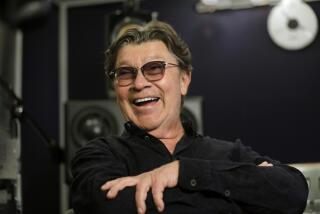MUSIC REVIEW : The Concertgebouw of Amsterdam: An Orchestra in Dutch
NEW YORK â Sooner or later, all the worldâs great orchestras play at Carnegie Hall. And most of them keep coming back.
The beloved landmark/auditorium, which opened in 1891, has never recovered fully from the well-intentioned but ill-advised acoustical renovation undertaken in 1986. Nevertheless, Carnegie remains a symbolic goal for serious musicians everywhere. Even with the sound a little fuzzier than it used to be (and the bass response a bit weaker), the hall still flatters its lucky occupants.
The occupants Sunday afternoon were Riccardo Chailly and the Royal Concertgebouw Orchestra of Amsterdam, another institution that has suffered certain losses with the progress of time.
Founded in 1888, the Dutch ensemble has long stood as one of the musical glories of the Western world. At its best, it has been celebrated for its extraordinarily burnished tone, its pervasive aura of warmth and its inevitable refinement. In recent years, however, it has sometimes sounded disconcertingly brash and brittle.
Donât blame the orchestra for that. Blame the man on the podium.
Chailly has served as chief conductor since 1988. The Milanese maestro is the first non-Dutchman to head the Concertgebouw, and only the fifth music director in its history.
He has had to follow in the formidable footsteps of Willem Mengelberg, Eduard van Beinum and Bernard Haitink. (Willem Kes, the Concertgebouw founder, is revered for administrative rather than musical achievements.) Though remarkably dissimilar, each of Hollandâs Big Three conductors savored heroic breadth and grandeur. Chailly seems to favor invigorating speed over expressive comfort.
The current tour brings Chailly and his orchestra to America for the first time in nearly five years. Other stops on the itinerary include Washington, Boston, Chicago and Ann Arbor, Mich. Forget the West Coast.
The repertory for this visit is mostly sentimental and safe. That may be unfortunate for Chailly, who enjoys something of a reputation as a champion of modernism. Although a publicity blurb assures us that âhe is particularly interested in 20th-Century music from the Netherlands,â we find no evidence of that interest on the export menus.
The introductory program at Carnegie was devoted to a couple of warhorse show-pieces: Bartokâs Concerto for Orchestra and Richard Straussâ âEin Heldenleben.â The former choice commemorates the 50th anniversary of Bartokâs death; the latter stands as a historic testimonial, for Strauss actually dedicated his massive tone poem to Mengelberg and the Concertgebouw in 1899.
The mighty, sprightly Bartok Concerto appeals more to the head than the heart. Under the circumstances, it gave the New York concert its better half.
This was hardly a big extrovert performance in the best snap-crackle-and-pop tradition. The Concertgebouw sounded relatively mild and mellow, even when a degree of grotesquerie would have been acceptable. Still, the performance was always brisk, bright and precise. It made good sense on its own unorthodox terms.
Chailly permitted no distortion and no exaggeration. The brass exerted astonishing power without ever getting rowdy, the woods sounded piquant rather than giddy, and those wondrous Dutch strings shimmered gently in the sonic mist. For all its intrinsic bravado, this remained an understated Concerto for Orchestra. In context, that didnât seem an oxymoron.
The same fine-grained restraint would have been welcome in âEin Heldenlebenâ after intermission. Unfortunately, Straussâ dramatic agitation seemed to cloud the conductorâs vision. Chailly churned out the narrative nervously and explosively. He chopped the expansive rhetoric in little pieces and lost the long line in the process.
His overwrought passion robbed the score of its spacious repose, diminished the legitimate climaxes, disturbed the delicate timbral balances and--horror of Dutch horrors--wrought havoc with basic laws of intonation. The ghost of Willem Mengelberg could not have been resting easy.
More to Read
The biggest entertainment stories
Get our big stories about Hollywood, film, television, music, arts, culture and more right in your inbox as soon as they publish.
You may occasionally receive promotional content from the Los Angeles Times.










